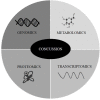Progress and Future Directions of the NCAA-DoD Concussion Assessment, Research, and Education (CARE) Consortium and Mind Matters Challenge at the US Service Academies
- PMID: 33101171
- PMCID: PMC7546354
- DOI: 10.3389/fneur.2020.542733
Progress and Future Directions of the NCAA-DoD Concussion Assessment, Research, and Education (CARE) Consortium and Mind Matters Challenge at the US Service Academies
Abstract
Despite the significant impact that concussion has on military service members, significant gaps remain in our understanding of the optimal diagnostic, management, and return to activity/duty criteria to mitigate the consequences of concussion. In response to these significant knowledge gaps, the US Department of Defense (DoD) and the National Collegiate Athletic Association (NCAA) partnered to form the NCAA-DoD Grand Alliance in 2014. The NCAA-DoD CARE Consortium was established with the aim of creating a national multisite research network to study the clinical and neurobiological natural history of concussion in NCAA athletes and military Service Academy cadets and midshipmen. In addition to the data collected for the larger CARE Consortium effort, the service academies have pursued military-specific lines of research relevant to operational and medical readiness associated with concussion. The purpose of this article is to describe the structure of the NCAA-DoD Grand Alliance efforts at the service academies, as well as discuss military-specific research objectives and provide an overview of progress to date. A secondary objective is to discuss the challenges associated with conducting large-scale studies in the Service Academy environment and highlight future directions for concussion research endeavors across the CARE Service Academy sites.
Keywords: baseline; biomarkers; concussion; head impact exposure; mild traumatic brain injury.
Copyright © 2020 Houston, O'Donovan, Trump, Brodeur, McGinty, Wickiser, D'Lauro, Jackson, Svoboda, Susmarski, Broglio, McAllister, McCrea, Pasquina and Cameron.
Figures



References
Publication types
LinkOut - more resources
Full Text Sources

